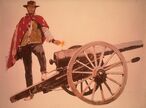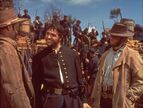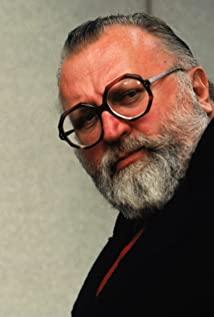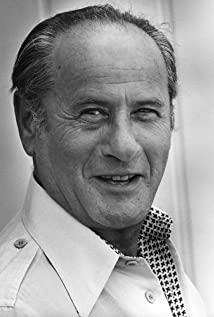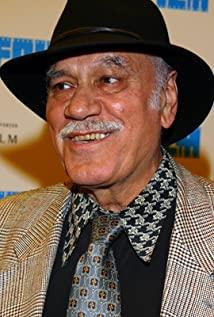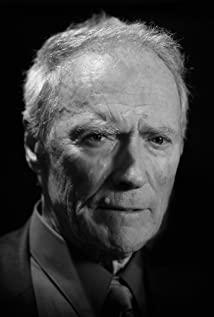①
What is a Western?
Lonely smoke in the desert, sunset in the long river, galloping horses, brave and majestic cowboys, or a life-and-death duel with guns back to back?
Andre Bazin said that those are just superficial symbols of westerns, which can neither define the film type of westerns nor generalize the charm of westerns. The essence of westerns is actually a myth.
The primary purpose of the birth of the myth is to respond to a demand for "shaping the common consciousness of the group." As a country of immigrants, the attraction and appeal of immigrants in the United States is based on the "American Dream" with clear logic and strong execution: "The ideal can be realized through personal struggle." This human history for hundreds of years The most influential recruitment advertisements have been updated and updated, with countless types of layout, color matching, and distribution channels, but the main slogan has never changed.
And in that era, in the era when "America" as a kind of group memory first originated, the history of individual struggle and the history of western pioneering at the national level perfectly matched.
Once the myth was passed on by word of mouth, and later published in Juan, before the proliferation of television and the Internet, movies became the best medium that modern humans have. In the battle between civilization and savagery, cowboy sheriffs confronted Indians and villains. They rode horses and revolvers on their waists, and built a modern order together with the train tracks.
In the majestic wild scenery and symphony, the western film has completely epicized the American people’s original western pioneering history, which was full of violence, blood, and sin, through firm optimism and simple, crude and even childish plots. It is romanticized and explained the "birth of a country."
②
Westerns are a highly stylized genre, so the huge differences in language, customs, and natural landscapes do not stop the popularity of Westerns in the world, especially in Europe, especially in Southern Europe. From geography to culture, the distance from the United States is on the contrary. Allowing more room for imagination, coupled with the urgent need to rejuvenate the European film industry after the war, easy to imitate, low cost, the key people's favorite Western films have become the first choice for European copycats. "Italian Westerns," or "Macaroni Westerns," was born.
It is precisely because of the naivety and stylization of American Westerns in the "classical period" that the macaroni Westerns that entered the "modification period" and even the "parody ironic period" quickly completed their rebellion against tradition. Sergio Leone is preparing On the stage of history.
Leone was born in an Italian film family, and he worked for De Sica in the early years and worked as an assistant director on the "Bike Thief" crew. As a great director of film history, he has only 7 works in his life, which is really not much. The debut film "The Colossus of Rhode Island" is an epic that followed the trend of Hollywood blockbusters at the time. Leonne put all the things he learned from his assistant careers in "Trojan Horse Slaughter" and "Benxu" into his mind. This film, accompanied by exquisite service and poor special effects, has received mediocre response from this memorable debut since then.
His next life belonged to two trilogy shining through the history of film and television-the "Fistful of Dollars" composed of "Red Dead Redemption", "The Red Guardian of the Twilight" and "The Good, the Good and the Ugly", as well as "Once Upon a Time in the West", "Revolutionary Past" and "American Past Events" constitute a "Trilogy of Past Events," five westerns and one gangster film, all about the United States.
Because of "Once Upon a Time in America", I thought for a long time that Lionel should be an American. Later, I discovered that not only the director is an authentic "foreigner", but the great movies about the West and the United States are all "foreign films." The American voted No. 1 in western film history, "The Good, the Bad and the Ugly" is still the highest-rated "foreign movie" on IMDB.
The shock at the above facts ultimately attributed to their admiration for "America" as a cultural phenomenon. To say "heroes in the world, join us in my heart", after Tang Taizong, it was the Yankees who said this, really deserved their name.
③
Standing in the ruins after World War II, Europeans fantasized about the United States as synonymous with hope, happiness, and freedom. The young Leone learned about the United States through news reports, novels, comics, and westerns. It is an unprecedented new country built by people all over the world, a religion, a melting pot, and the most magnificent human dream ever. Aggregate. There are epic heroes, there are cowboy rangers, there are railroad tracks that cross the entire continent, without beginning and end.
"As a European, America attracts me and surprises me. The more I like her, the more I feel light years away from her. I like the vigor and vitality of Americans, and the endless contradictions also fascinate me. It is this mixture of vigor and contradiction that makes her so unique.
America is a mixture of dream and reality. In the United States, dreams will become reality without knowing it, and reality will suddenly become a dream without knowing it. This is what I feel most deeply. Dream and reality always contradict, only in the United States, they are so distinctly opposed and unified.
The United States is Griffith plus Spielberg, Watergate plus Martin Luther King, Johnson plus Kennedy. Italy is just an Italy, France is just a France, and the United States is the whole world. The problems of the United States are common problems all over the world: contradictions, fantasies, and poetry. "
"Contradiction" is actually a key word for understanding Sergio Leoni.
④
Leonie always envied John Ford's naive and positive optimism. As a descendant of Ireland, the protagonist in John Ford's lens always carries a noble moral standard that is almost religious, ambitiously yearning and pursuing a dreamy future.
But Leoni couldn't do it, "As descendants of Rome, we always bear the scars of the empire's decline and a strong sense of frustration. And the Western world in my eyes is not only violence, but violence."
He is undoubtedly violent.
Waking up from the golden American dream, looking at a wasteland full of crises, the Indians have gone, and now walking through them are lone killers, bounty hunters, and bandits. Strolling around with a horse while blowing a whistle has become a desperate act. In the next second, you will be thrown down by a cold gun and a horse and a person outside the frame. The protagonist got rid of the shackles of a role model of justice early, and the moral standards even went from bad to worse in the trilogy-the ranger who was influenced by "Intentional Stick" in the first part was set to the second part, and he became a man who only worked for the bounty. Hunter, to the third part, is an occasional part-time scammer.
But he is also warm and even compassionate.
Bazin once summed up that in order to adapt to the character of the protagonist, traditional Western films clearly pursue a kind of epic in the structure of the picture. There are no close-up shots, and almost no close-up or mid-field half-length shots are needed, unless it is to capture a heroic moment. They prefer panoramic and distant shots, use panning and moving photography to deny the scene frame, try to create a magnificent and more magnificent sense of space through motion, and place heroes and horses on the horizon, complete nature, and In a desperate struggle between man and nature.
On the contrary, Leone, the rebel, not only introduced a large number of close-up shots in westerns, but also opened these meticulous observations and gazes equally to everyone, heroes, villains, small people who may die at any time, and even group portraits. He is always willing to use the slow pan camera to show the onlookers, show their irrelevant identities, emotions and environment, or aim at the southern soldiers who endured pain and insult in the prisoner of war camp and show them with a long gaze. Grief and humiliation. Leone may have created a western world where violence is too rampant, but it is also here that "life" has gained unprecedented respect.
Because of this, he was soothing and even, he used a lot of adagio pans and close-ups in the movie unscrupulously. This self-confidence of "daring to be subtle" occasionally challenged the patience of the audience, so that many comments criticized him at that time. "Endless".
At the end of "The Good, the Bad and the Ugly" is probably the most famous duel in film history, he spent 5 minutes and 74 shots to show the plot of a few seconds. The difference between "movie time" and "story time" has been strangely enlarged in the opposite direction. The act of duel has acquired a solemn sense of ritual in the stretched event, and the audience, as the ceremonial observer, has to hold their breath and accelerate. Heartbeat, looking forward to the moment when the suspense of life and death is revealed.
For this sense of ritual, the dueling cowboys are like gladiators being placed in the Colosseum in ancient Rome. They are placed in various "circles" by the camera. The major's revenge in "The Red Dead" takes place in an earthen wall. The duel in "The Good, the Good and the Good" took place in the center of the huge circular cemetery at Desolate Mountain Cemetery.
In Martin Scorsese's view, this is a transplantation and improvement of Italian opera arias, although Leonne himself denied this.
He is soothing, but also obsessed with "fast". Although there is no evidence that Eastwood played the same role in the trilogy, this tall and handsome cowboy can always surprise the four with his "quick gun" skills. Because of the "Hays Code", American Western movies have a lot of scruples about the display of violence. They often break down the shots. In one shot, someone shoots, and in the next shot someone falls to the ground. But Leone likes to The actions of taking out a gun, shooting and falling to the ground are shown in a camera. In the first second, the cowboy drank with his back to a group of enemies calmly and calmly. The next second, he turned around and took out the gun "pia! pia! pia" !", there is no false case.
The cowboys in Leon are always lazy and decadent, and occasionally think about life without proper work, but whenever and wherever they shoot, they are always unthinkable.
⑤
Leone’s debut work was mediocre, and it coincided with the sluggish Italian film market. In order to make money and support his family, he had to rack his brains to find movies to shoot. At that time, the domestic western film copycat style in Italy had begun to take shape. After seeing Akira Kurosawa’s "Intentional Stick", he unceremoniously adapted it into a Western film. Because the budget was stretched, he could not please Henry. Fonda hired the fledgling Clint Eastwood as the male lead. "Red Dead Redemption" was originally called "Per un pugno di dollari", which translates to "To Earn Some Dollars".
Akira Kurosawa praised the film, "It was really good!" At the same time, he was very angry, "But it's totally my movie!" So he took Leone and the production company to court and obtained the award. The film’s distribution rights in Japan, South Korea and Taiwan and 15% of the film’s global box office.
The production company therefore fell out with Leone and refused to pay his salary. Leoni, who was not planning to continue filming westerns, summoned the original crew and filmed "The Fistful of Dusk", the Italian name is "Per qualche dollaro in più", "in order to earn some more dollars."
Finally, there is the great "The Good, the Bad and the Good." At the end of this movie, the good guy took off his coat and used a cigarette to deliver the dying Confederate soldier to the end. Then he put on the Mexican cloak that the soldier threw aside, and rode his horse to the little boy of "Red Dead Redemption". town. In the "Sense of Ceremony" we mentioned Leon's preference for "circle". In fact, the entire "Funker Trilogy" is connected end to end, and finally formed a circle.
In the hands of Leon, who is good at and loves flashbacks, even the fierce villain is often melancholy indulging in the past, but Eastwood always comes and goes smartly. He has no name, no past, and doesn't seem to care much. In the future, he will just walk arrogantly and happily on the wilderness of his own destiny, without beginning and end.
View more about The Good, the Bad and the Ugly reviews



